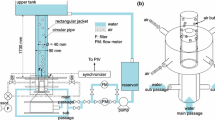Abstract
The hydrodynamics and the flow field in an agitated vessel were measured using 2-D time resolved particle image velocimetry (2-D TR PIV). The experiments were carried out in fully baffled cylindrical flat bottom vessels 300 and 400 mm in inner diameter. The 300 mm inner diameter tank was agitated by a Rushton turbine 100 mm in diameter, and the 400 mm inner diameter tank was agitated by a Rushton turbine 133 mm in diameter. Three liquids of different viscosities were used as the agitated liquid: (i) distilled water (ν = 9.35 × 10–7 m2/s), (ii) a 28 vol % aqueous solution of glycol (ν = 2 × 10–6 m2/s), and (iii) a 43 vol % aqueous solution of glycol (ν = 3 × 10–6 m2/s). The velocity fields were measured at an impeller rotation speed in the range from 300 to 850 rpm, which covers the Reynolds number range from 50000 to 189000. This means that fullydeveloped turbulent flow was reached. The experiments were performed to investigate the applicability of the following relations: ε* = ε/(u4/ν) = const, vK/u = const, Λ/ηK = const, τΛ/τK = const, ε* = ε/((Nd)4/ν) = const, Λ/d ∝ Re–1, ηK/d ∝ Re–1, vK/(Nd) = const, NτΛ ∝ R–1, NτK ∝ Re–1, and ε/(Nq) ∝ Re. These formulas were theoretically derived in our previous work, using turbulence theory, in particular, using turbulence spectrum analysis. The correctness of the proposed relations is investigated by statistical hypothesis testing.
Similar content being viewed by others
References
Šulc, R. and Ditl, P., Local turbulent energy dissipation rate in agitated vessel: New approach to a dimensionless definition, Theor. Found. Chem. Eng., 2017, vol. 51, p.159. http://dx.doi.org/ doi 10.1134/S0040579517020105.
Khan, F.R., Rielly, C.D., and Brown, D.A.R., Angleresolved stereo-PIV measurements close to a down-pumping pitched-blade turbine, Chem. Eng. Sci., 2006, vol. 61, p. 2799. http://dx.doi.org/ doi 10.1016/j.ces.2005.10.067.
Kresta, S.M. and Wood, P.E., The flow field produced by pitched blade turbine: characterization of the turbulence and estimation of the dissipation rate, Chem. Eng. Sci., 1993, vol. 48, p. 1761. http://dx.doi.org/doi 10.1016/0009-2509(93)80346-R.
Šulc, R., Pešava, V., and Ditl, P., Local energy dissipation rate in an agitated vessel–a comparison of evaluation methods, Proc. 15th European Conference on Mixing, Saint Petersburg, 2015.
Liné, A., Gabelle, J.C., Morchain, J., Anne-Archard, D., and Augier, F., On POD analysis of PIV measurements applied to mixing in a stirred vessel with a shear thinning fluid, Chem. Eng. Res. Des., 2013, vol. 91, p. 2073. http://dx.doi.org/ doi 10.1016/j.cherd.2013.05.002.
Jašíková, D., Kotek, M., and Kopecký, V., Time resolved PIV measurement of fluid dynamics in agitated vessels, Proc. SPIE 9442 Optics and Measurement Conference 2014, 94420H, 2015. http://dx.doi.org/ doi 10.1117/12.2176018.
Sheng, J., Meng, H., and Fox, R.O., A large eddy PIV method for turbulence dissipation rate estimation, Chem. Eng. Sci., 2000, vol. 55, p. 4423. http://dx.doi.org/doi 10.1016/S0009-2509(00)00039-7.
Zhao, J., Gao, Z., and Bao, Y., Effects of the blade shape on the trailing vortices in liquid flow generated by disc turbines, Chin. J. Chem. Eng., 2011, vol. 19, p. 232. http://dx.doi.org/ doi 10.1016/S1004-9541(11)60160-2.
Ståhl Wernersson, E. and Trägårdh, C., Scaling of turbulence characteristics in a turbine-agitated tank in relation to agitation rate, Chem. Eng. J., 1998, vol. 70, p. 37. http://dx.doi.org/ doi 10.1016/S1385-8947(98)00071-0.
Ståhl Wernersson, E. and Trägårdh, C., Turbulence characteristics in turbine-agitated tanks of different sizes and geometries, Chem. Eng. J., 1999, vol. 72, p. 97. http://dx.doi.org/ doi 10.1016/S1385-8947(98)00147-8.
Šulc, R., Pešava, V., and Ditl, P., Local turbulent energy dissipation rate in a vessel agitated by a Rushton turbine, Chem. Process Eng., 2015, vol. 36, p. 135. http://dx.doi.org/ doi 10.1515/cpe-2015-0011.
Šulc, R., Pešava V., and Ditl, P., Estimating the local turbulent energy dissipation rate using 2-D PIV measurements and a 1-D energy spectrum function, Theor. Found. Chem. Eng., 2015, vol. 49, p. 145. http://dx.doi.org/ doi 10.1134/S004057951502013X.
Delafosse, A., Collignon, M.L., Crine, M., and Toye, D., Estimation of the turbulent kinetic energy dissipation rate from 2D-PIV measurements in a vessel stirred by an axial Mixel TTP impeller, Chem. Eng. Sci., 2011, vol. 66, p. 1728. http://dx.doi.org/doi 10.1016/j.ces.2011.01.011.
Saarenrinne, P. and Piirto, M., Turbulent kinetic energy dissipation rate estimation from PIV vector fields, Expt in Fluids, 2000, vol. 29, S300–S307. http://dx.doi.org/ doi 10.1007/s003480070032.
Piirto, M., Eloranta, H., and Saarenrinne, P., Interactive software for turbulence analysis from PIV data, Proc. 10th Int. Symp. on Applications of Laser Techniques to Fluid Mechanics, Lisbon, 2000.
Baldi, S., Hann, D., and Yianneskis, M., On the measurement of turbulence energy dissipation in stirred vessels with PIV techniques, Proc. 11th Int. Symp. Applications of Laser Techniques to Fluid Mechanics, Lisbon, 2002.
For, I., Obeid, A., and Brezina, V., Flow of liquid in a cylindrical vessel with a turbine impeller and radial baffles, Coll. Czechoslov. Chem. Comm., 1982, vol. 47, p. 226. http://dx.doi.org/ doi 10.1135/cccc19820226.
Bowerman, B.L. and O’Connell, R.T., Applied Statistics: Improving Business Processes, Homewood, IL: Richard D. Irwin, 1997.
Huchet, F., Liné, A., and Morchain, J., Evaluation of local kinetic energy dissipation rate in the impeller stream of a Rushton turbine by time-resolved PIV, Chem. Eng. Res. Des., 2009, vol. 87, p. 369. http://dx.doi.org/ doi 10.1016/j.cherd.2008.11.012.
Kysela, B., Konfršt, J., Chára, Z., and Kotek, M., Evaluation and accuracy of the local velocity data measurements in an agitated vessel, EPJ Web of Conferences 67, 2014, article 02064. http://dx.doi.org/ doi 10.1051/epjconf/ 2014670206510.1051/epjconf/20146702065.
Derksen, J. and Van den Akker, H.E.A., Large eddy simulations on the flow driven by a Rushton turbine, AIChE J., 1999, vol. 45, p. 209. http://dx.doi.org/ doi 10.1002/aic.690450202.
Li, Z., Bao, Y., and Gao, Z., PIV experiments and large eddy simulations of single-loop flow fields in Rushton turbine stirred tanks, Chem. Eng. Sci., 2011, vol. 66, p. 1219. http://dx.doi.org/ doi 10.1016/j.ces.2010.12.024.
Author information
Authors and Affiliations
Corresponding author
Additional information
The article is published in the original.
Rights and permissions
About this article
Cite this article
Ditl, P., Šulc, R., Pešava, V. et al. Local Turbulent Energy Dissipation Rate in an Agitated Vessel: Experimental and Turbulence Scaling. Theor Found Chem Eng 52, 122–134 (2018). https://doi.org/10.1134/S0040579518010037
Received:
Published:
Issue Date:
DOI: https://doi.org/10.1134/S0040579518010037



